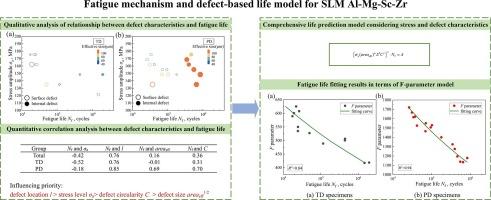The fatigue mechanism and a new defect-based life prediction model for selective laser melted Al-Mg-Sc-Zr alloy
Abstract
Additive manufacturing (AM) has broad application prospects in the field of aviation, whereas it remains a challenge to fully eliminate the manufacturing defects. As a result, the fatigue performance is poor and has a large scatter. The fatigue performance and life prediction method have become a major hindrance for the application of AM in aviation field. In this paper, the microstructure and defect characteristics of SLM Al-Mg-Sc-Zr alloy that built in transverse direction (TD) and parallel direction (PD) were studied. Then the fatigue performance was investigated, and the relationship between critical defect characteristics and fatigue life was analyzed qualitatively and quantitatively based on fracture analysis. The microstructure exhibits a bimodal grain structure with fine grain size. The defect study shown that there are more large-size defects and higher porosity in the PD specimens. The fatigue life is significantly influenced by the location, size and circularity of critical defects and stress amplitude. Correlation analysis suggested that the defect location is the most influential factor on fatigue performance, followed by stress amplitude, defect circularity and defect size. Finally, a fatigue life prediction model based on stress amplitude and defect characteristics of the critical defects was proposed.


 求助内容:
求助内容: 应助结果提醒方式:
应助结果提醒方式:


